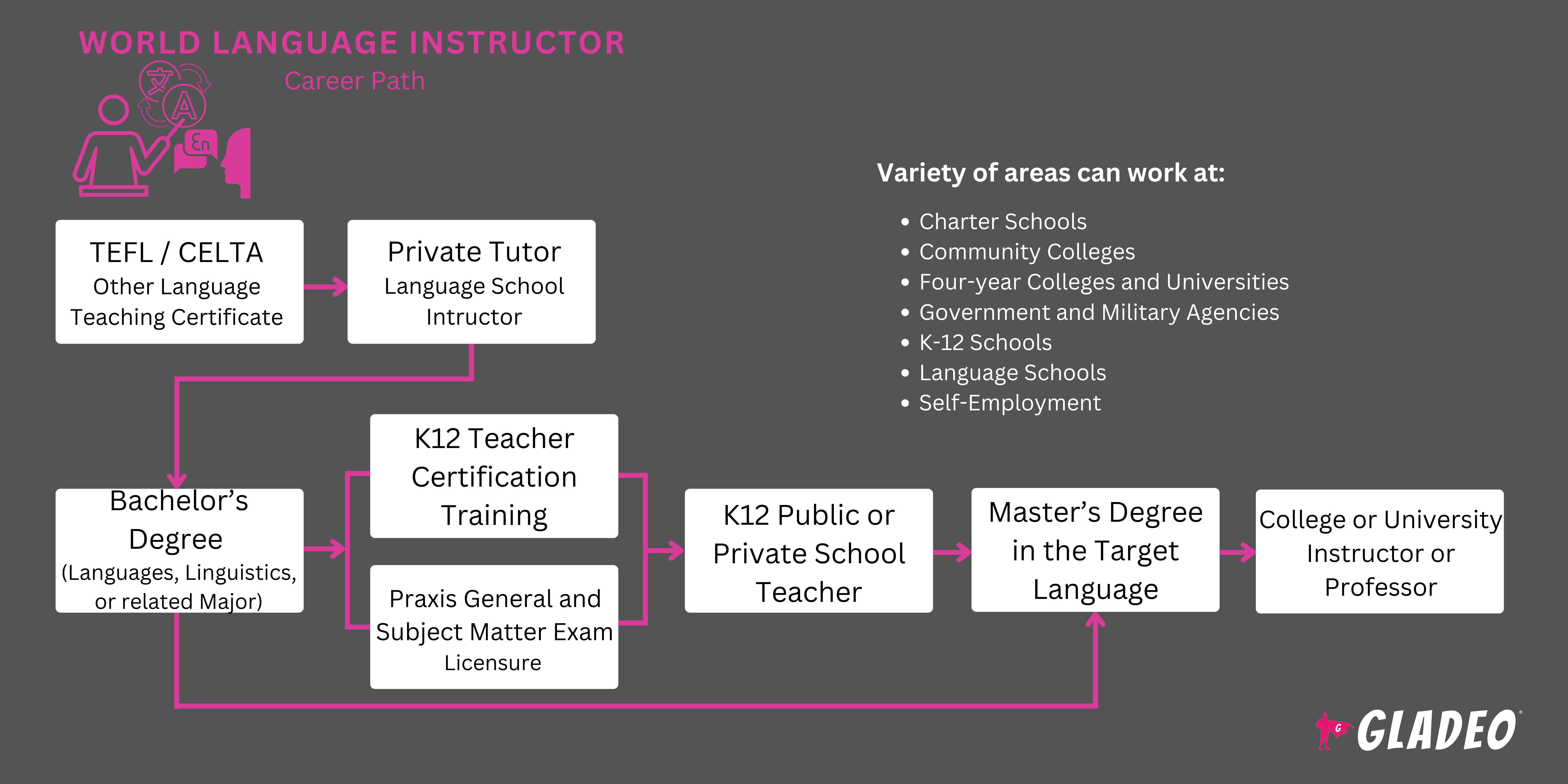聚光灯
Assistant Professor, Associate Professor, Foreign Languages Professor, French Professor, German Professor, Instructor, Modern Languages Professor, Professor, Spanish Instructor, Spanish Professor
There are ~7,000 languages spoken in the world, and ~43% of the population speaks at least two of them. Many were raised in bilingual households or exposed to multiple languages in their communities. Others learn by taking formal language courses as a school elective or hobby or to prepare for a trip to a different country. These language courses are usually taught by a trained Language Instructor!
World Language Instructors work in K-12 schools, colleges, and specialized language schools. Some work independently as private tutors. Their job is to help students acquire new language skills that are useful for communication as well as better cultural understanding. First, they determine the current proficiency level of their target students, then develop creative lesson plans, teach lessons in-person or online, facilitate classroom discussions and activities, and assess progress through exams and assignments.
Depending on their own proficiency, instructors may teach only certain levels, such as beginner, intermediate, or advanced courses. Overall, their goal is to help students learn how to speak, listen, read, write, and think in a second language. Some classes have specific goals like improving grammar and composition skills, accent reduction, or building business vocabulary in the new language.
- Witnessing student improve their proficiency in the new language
- Promoting cultural awareness and understanding
- Opportunities to work in diverse educational settings
- Engaging with students from various backgrounds and cultures
工作日程
World Language Instructors may work full or part-time depending on their employment situation. Hours may include nights or weekends. When they aren’t teaching, they need to spend time preparing for upcoming lessons or grading assignments.
典型职责
- Select or design a curriculum suitable to the level of the student or classroom. Pick appropriate textbooks and workbooks.
- Make a lesson plan for the month, term, or year. Disseminate syllabi, as needed.
- Prepare lessons including handouts, materials, assignments, or quizzes. Choose a variety of materials to keep students’ attention.
- Teach lessons and engage students to participate. Provide ways for students to practice receptive skills (such as reading and listening) and productive skills such as speaking and writing.
Issue homework assignments with due dates. Grade and comment on assignments. - Give tests and quizzes. Review and grade these exams.
- Maintain attendance records and grade logs. Input information into databases or learning management systems.
- Track student progress and support students struggling with a topic or area.
- Adjust teaching methods if necessary to accommodate student learning needs.
- Establish consistent office hours to meet and advise students one-on-one. Serve on school committees to share opinions about policies, problems, and departmental matters.
- Act as an adviser to language-related student groups.
- Work with schools, students, and parents to facilitate immersion or study abroad programs.
额外责任
软技能
- 适应性
- 协作
- 创造性
- 文化敏感性
- 有帮助他人成功的愿望和本领
- 同理心
- 热情
- 人际交往技巧
- 敏锐的组织能力
- 耐心
- 坚韧不拔和沉着冷静
- 健全的判断和决策
- 强大的沟通能力
- 时间管理
技术技能
- Proficiency in the target language suitable to the level being taught
- Ability to assess and guide student behavior
- Classroom management and student engagement strategies
- Cultural awareness and integration into language instruction
Curriculum development - Familiarity with language proficiency exams like IELTS and TOEFL
Language learning apps and software - Pronunciation training and phonetics expertise
- 协调和指导活动的技能
- Understanding of language teaching pedagogy
- Use of educational technology such as learning management systems
- K-12学校
- 特许学校
- 社区学院
- Four-year colleges and universities
- Language schools
- 政府和军事机构
- 自营职业
World Language Instructors are expected to maintain a high level of language proficiency and stay updated on educational best practices. Not all instructors hold traditional teaching licenses or credentials, which may limit their employment options. For example, to teach in the public K-12 system, workers need to meet certain training and licensure requirements. To teach at a college, one may need a master’s degree. However, to teach at a language school or as a private tutor, there may be no hard requirements to meet.
For those who work in K-12 schools or colleges, there may be additional responsibilities such as serving on committees or helping with school-related activities. Summer breaks often result in a few weeks away from teaching, which can impact salaries for some instructors.
Language-learning methods and courses like Berlitz, Pimsleur, and Rosetta Stone helped pave the way for the abundance of new programs and apps on the market today. Now students can learn on the go via mobile apps like Duolingo, Babbel, Memrise, Busuu, and dozens more.
To some extent, the prevalence of these easy-to-use, relatively affordable options has impacted employment opportunities for World Language Instructors. In addition, the rise and increasing sophistication of instant translation programs is making it far easier to communicate in other languages without even having to learn them.
Instead of ignoring these tools, tech-savvy World Language Instructors are incorporating them into their classrooms and learning environments, using them to supplement their own work. Students can benefit from a mix of live instruction and practice with online programs, making learning more engaging and accessible.
Communicative language teaching methods are also shaping modern instruction, emphasizing real-life interaction over memorization. This practical approach encourages students to actively use the target language in meaningful ways while helping them get past the “awkwardness” they may feel from making mistakes along the way.
World Language Instructors sometimes grew up in bilingual households – or they simply enjoyed learning about other cultures and new languages. As teachers, they tend to be outgoing and eager to help others learn. These are often inherent traits they may have developed at home or in school.
- Educational requirements for World Language Instructors vary based on their work setting. For example:
- Private tutors who work for themselves don’t have any hard requirements.
- Tutors who work for a company (such as a language school) may need at least a high school diploma or equivalent, proof of proficiency in the target language, and a certification of some type (like the Certificate in Teaching Spanish as a Foreign Language), depending on what the employer wants.
- Private charter school teachers may need a bachelor’s degree. A license or experience is preferred.
- Public K-12 school teachers need a bachelor’s degree and a state license or certification to teach. They must finish a teaching program in college, complete a background check, and pass two exams — a general teaching exam plus a subject matter exam.
• General teaching exams include the Praxis Core (administered by ETS) and National Evaluation Series (administered by Pearson). These organizations also offer subject matter exams for various languages.
- College-level instructors and professors usually hold a master’s or PhD related to the target language.
- Not all World Language Instructors need a college degree. Those who choose to pursue one should consider where they want to work, to determine the most appropriate major.
- K-12 teachers should seek undergraduate programs that feature teacher certification routes.
- Those who want to teach at a college level should plan ahead for suitable graduate programs, focused on advanced language skills, literature, culture, and linguistics.
- Look for accredited programs with well-regarded faculty members and opportunities for study abroad and language practice.
- Compare tuition and other costs between schools to make sure you’re getting the best value for your money.
- Compare online, on-campus, and hybrid programs to find a suitable option for your lifestyle.
- 查看毕业和就业安置统计数据。
- Decide what proficiency level you want to teach (beginner, intermediate, or advanced) and the age group you want to teach (young children, middle schoolers, high school students, college students, or adult learners).
- Choose the settings where you want to teach, such as in a public K-12 school, a charter school, a college, a private language school or company, or from home as an online tutor.
- Ask your own language teacher(s) for guidance and mentorship!
Volunteer to help your teachers so you can learn about classroom activities and management. - Teach someone you know a new language. Take note of what works and doesn’t work.
- Improve your proficiency in the target language. Also hone your English, writing, public speaking, and project management skills!
Participate in language-related clubs and activities. Try to do a study abroad or cultural exchange program. - Read articles and watch videos related to language teaching pedagogy.
- Keep up with the latest methods for incorporating technology into the classroom.
- Create a working resume to track experiences and academic accomplishments.
- Look for volunteer, freelance, or substitute teaching opportunities at schools, youth organizations, cultural centers, or other institutions with potential language learners.

- How to land your first job depends on what type of job you want, so be sure you know the education and training requirements and have them completed before applying.
- If you’d like to be a K-12 teacher but haven’t finished your bachelor’s, consider applying as a part-time teacher assistant to gain experience in the classroom. Assistant roles may only require an associate’s degree.
- Try starting as a substitute teacher or tutor. Tutors are in high demand in many areas due to nationwide teacher shortages.
Apply for open positions found on Indeed.com, EdJoin.org, and other job-seeking sites. - Attend job fairs and career events related to education and language learning.
- Use quantifiable results on your resume (such as how many learners you’ve taught or what percentage of the classroom’s overall GPA went up).
- List all practical experience you have of working with youth, including internships or volunteer work.
- Incorporate keywords in your resume such as:
- Bilingual Education
- Communicative Language Teaching (CLT)
- Grammar Instruction
- Interactive Learning Methods
- Language Assessment Tools
- Language Immersion
- Phonetics and Pronunciation
- 阅读理解
- Second Language Acquisition
- Vocabulary Building
- Writing Proficiency
- Most jobs are found through connections, so ask your network for leads on upcoming job openings.
Keep up-to-date on the latest language pedagogy developments. - Ask previous teachers and supervisors to write recommendation letters or request their consent to list them as references.
- Research potential employers (i.e., K-12 school districts, charter schools, community colleges, universities, online schools, language schools, etc.). Learn about their mission, values, and priorities so you can find a good match.
- Review sample teacher resumes and interview questions. Remember, there are different templates and interview questions for different teaching levels and roles.
- For example, a college professor usually needs a CV listing their relevant publication history. They may also need to submit research, teaching, and diversity statements.
- Conduct mock interviews with friends or your educational program’s career center staff, if offered.
- During interviews, demonstrate awareness of trends and terminology. Articulate your enthusiasm for working with language learners and explain why you’re the best candidate.
- Learn how to dress for a teacher interview.
- How you “climb the ladder” depends on which ladder you’re on, and where you want to go!
- If you’re a private tutor, look for job openings at a language school or complete a teaching certification program to work in a K-12 setting.
- If you’re a K-12 teacher and want to move into a leadership position, knock out some extra education and training, such as a Master of Education in Educational Administration. Also, when you have gained enough experience, get an optional National Board of Professional Teaching Standards certification to boost your resume.
- If you’re a college instructor or adjunct, ask your supervisor for advice on how to qualify for a tenure-track professor position.
- If you're a college professor on a tenure track, keep hitting your goals and making progress!
- Grow your reputation as a subject matter expert. Get published in academic journals, write online articles, make tutorial videos, mentor peers, and participate in professional organizations like the American Council on the Teaching of Foreign Languages.
- Consider making your own website or social media channel related to your area of expertise, where users can learn and share information.
- Serve on high-visibility school and district committees and make an impression.
- Strengthen relationships with students, staff, teachers, and administrators.
- Stay creative! Explore innovative ways to teach your subject matter to keep learners motivated.
- Keep up with developments in using technology to enhance learning. Remember, as the American Council on the Teaching of Foreign Languages (ACTFL) states, “Research does not support the isolated use of technology for acquiring a language.” However, “Technology can and should be used by language educators to enhance language instruction, practice, and assessment, as articulated in the World-Readiness Standards for Learning Languages.”
网站
- American Association of Teachers of French
- American Association of Teachers of German
- American Association of Teachers of Japanese
- American Association of Teachers of Spanish and Portuguese
- American Association of University Professors
- 美国外语教学理事会
- 美国教师联合会
- Association for Asian Studies
- Association of Academic Programs in Latin America and the Caribbean
- 计算机专业人员促进社会责任协会
- 教育工作者资格认证委员会
- German Studies Association
- Latin American Studies Association
- Modern Language Association
- 国家专业教学标准委员会
- 全国教育协会
- National Network for Early Language Learning
- 全国家长教师协会
- 全国辅助教育工作者资源中心
- Southeastern Council of Latin American Studies
- TEACH.org
- Teachers of English to Speakers of Other Languages (TESOL)
- The Classical Association of the Middle West and South
- U.S. Department of Education
Magazines and Blogs
- Actual Fluency Blog
- Babbel Magazine
- Fluent in 3 Months
- Eurolinguiste
- FluentU Blog
- Glossika Blog
- Language Learning Hub
- Language Magazine
- LingQ Blog
- Lingualift Blog
- Luca Lampariello
- Omniglot Blog
- Polyglot Club Blog
- Street-Smart Language Learning
- The Linguist
- The Mezzofanti Guild
书籍
- Approaches and Methods in Language Teaching, by Jack Richards and Theodore Rodgers
- Second Language Acquisition Myths, by Steven Brown and Jenifer Larson-Hall
- Teaching Language in Context, by Alice Omaggio Hadley
- Techniques and Principles in Language Teaching, by Diane Larsen-Freeman
Teaching languages can be fun and rewarding! But with the rise of self-learning apps and instant translation programs, the field is projected to see a dip in employment in the coming years. If you’re curious about other academic and school-related careers, consider related fields such as:
- 学术顾问
- Adult Basic Education Instructor
- Career and Technical Education Teacher
- 职业顾问
- College Instructor or Professor
- Elementary School Teacher
- English As A Second Language Instructor
- High School Teacher
- 人力资源部门
- Interpreter and Translator
- Middle School Teacher
- 学校辅导员
- 手语教师
- 特殊教育教师
- 体育教练
- 教师助理
新闻联播

特色工作

在线课程和工具








